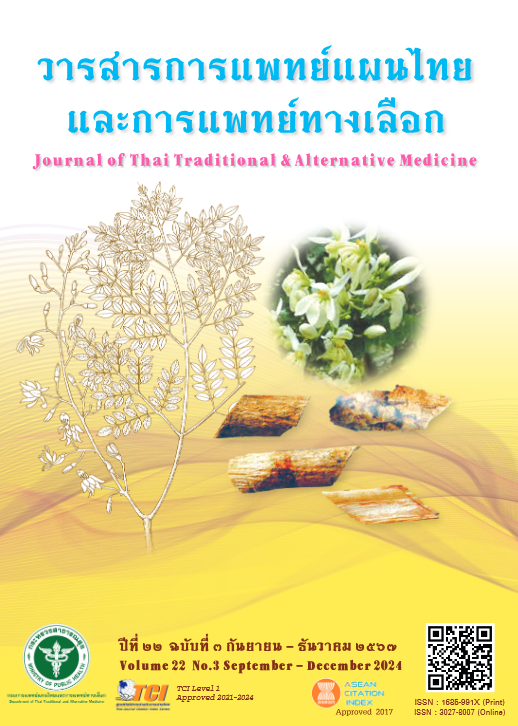Development of Analytical Methods and Validation of Cannabinoid Quantification Methods in Cannabis sativa L. Flowers by Ultra High Performance Liquid Chromatography
Main Article Content
Abstract
Introduction and objective: Cannabis (Cannabis sativa L.) has been used to treat several diseases since ancient time. Tetrahydrocannabinol (THC) is the major psychoactive compound and the other non-psychoactive ingredients are cannabidiol (CBD) and cannabinol (CBN). Cannabis has been used as an active ingredient of several drugs and products in the markets. However, the appropriate analytical methods for quality control of those compounds are still limited. This study aimed to develop analytical methods for quantification assessment of CBD, CBN and THC in cannabis flower samples using the Ultra-High Performance Liquid Chromatography (UHPLC) technique.
Methods: The study was divided into three steps: developing the UHPLC method for analyzing cannabidiol, cannabinol and tetrahydrocannabinol in cannabis flowers, testing the validity of the analysis method, and analyzing the quantity of cannabidiol, cannabinol and tetrahydrocannabinol in 12 cannabis flower samples.
Results: This method was validated by establishing the linearity for cannabidiol, cannabinol and tetrahydrocannabinol at the concentration range of 1.05–104.90, 1.00–99.60 and 1.00–99.90 μg/mL, respectively, with a determination correlation coefficient (r) of 0.999. The % recovery was in the range of 98.99–100.39%. The limit of detection of cannabidiol, cannabinol and tetrahydrocannabinol was 0.612, 0.872 and 0.320% w/w (calculated on the dry weight as C. s sativa flowers, µg/µg), respectively, while the limits of quantification were 2.041, 2.908, and 1.066% w/w (calculated on the dry weight as C. sativa flowers, µg/µg), respectively.
Discussion: The method developed for analyzing cannabidiol, cannabinol and tetrahydrocannabinol in raw cannabis flowers using UHPLC involves the extraction of dried cannabis flowers with ethanol as the solvent through the reflux method. The validity test results for the analysis method all fell within acceptable limits. This developed analysis method requires less time for analysis and involves a simple, convenient, and rapid preparation of the mobile phase.
Conclusion and recommendation: This recently developed method proves suitable for analyzing the levels of cannabidiol, cannabinol and tetrahydrocannabinol in cannabis flowers. It enables the establishment of accurate specifications for these compounds in cannabis flowers.
Article Details

This work is licensed under a Creative Commons Attribution-NonCommercial-NoDerivatives 4.0 International License.
References
Boonyaprapat N, Chokchaicharoenporn O. Medicinal plants indigenous to Thailand. Bangkok: Prachachon; 1999. 3(1): p. 693. (in Thai)
Mechoulam R, Hanuš LO, Pertwee R, Howlett AC. Early phytocannabinoid chemistry to endocannabinoids and beyond. Nature Reviews Neuroscience. 2014;15:757.
Velasco G, Sánchez C, Guzmán M. Towards the use of cannabinoids as antitumour agents. Nature Reviews Cancer. 2012;12:436.
Office for the Management of Cannabis and Kratom in Thai Traditional Medicine. Infographic 16 recipes of traditional Thai medicine containing cannabis [Internet]. 2021; [cited 2021 July 2]; [1 screen]. Available from: https://ockt.dtam.moph.go.th/index.php/cannabis-formula/200-infographic-16
Radapong S, Suppajariyawat P, Phadungkit M. Pharmacological and toxicological effects of cannabis. The Bulletin of the Department of Medical Sciences. 2021;63(1):221-4. (in Thai)
Veniero G, Lucia D, Fiorenza F, Rino F, Elisa S, Giovanna T. Determination of primary active constituents in cannabis preparations by high-resolution gas chromatography/flame ionization detection and high-performance liquid chromatography/UV detection. Analytica Chimica Acta. 2002;468:245–54.
Laura A. Ciolino, Tracy L. Ranieri, Allison M. Taylor. Commercial cannabis consumer products part 2: HPLC-DAD quantitative analysis of cannabis cannabinoids. Forensic Science International. 2018;289:438-47.
Department of Medical Science. Practical guidlines for testing the accuracy of chemical analysis methods in the single laboratory setting. Nonthaburi: Department of Medical Science; 2006.
Hazekamp A, Fischedick JT, Llano Díez M, Lubbe A, Ruhaak RL.
Chemistry of cannabis. Comprehensive Natural Products II. 2010;3:1033-84.
Russo EB, Marcu J. Chapter Three - Cannabis Pharmacology: The Usual Suspects and a Few Promising Leads. Advances in Pharmacology. 2017; 80: 67-134.


